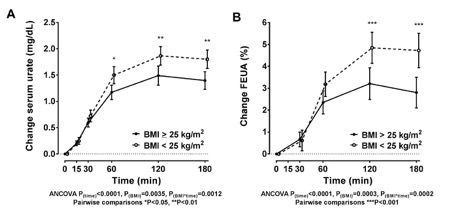Session Information
Session Type: ACR Poster Session B
Session Time: 9:00AM-11:00AM
Background/Purpose: Increased body mass index (BMI) is an important risk factor for hyperuricemia and gout. It is unknown whether overweight and obesity influences serum urate primarily through increased urate production or reduced renal clearance of uric acid. Inosine is a purine nucleoside that functions as an intermediate in the purine salvage and degradation pathways. Oral administration of inosine allows analysis of the effects of a standardized purine load on both serum urate concentrations and renal uric acid handling. The aim of this study was to determine the influence of body mass index on the response to an inosine load.
Methods: Following an overnight fast, 100 healthy participants, recruited by public advertising, attended a study visit. Exclusion criteria included chronic kidney disease stage 3 or worse, gout, diabetes mellitus and diuretic use. Blood and urine samples were obtained for urate and creatinine, prior to and then 15, 30, 60, 120, and 180 minutes after a single oral 1.5g dose of inosine. Clinical features including age, sex, ethnicity and BMI were recorded. Data were analysed according to increased BMI (25kg/m2 or more) and low/normal BMI (less than 25kg/m2). The primary endpoint was change in serum urate and secondary endpoint was change in fractional excretion of uric acid (FEUA). Data were analysed using a mixed models approach to repeated measures.
Results : In the entire study population, oral intake of inosine led to large increases in serum urate (mean increase 1.6mg/dL) and FEUA (mean increase 3.7%) over the 180 minute study period (P<0.0001 for both). Although participants in the increased BMI group (n=52) had higher serum urate concentrations at baseline (age, sex, ethnicity-adjusted P=0.002), this group had a smaller increase in serum urate following the inosine load (age, sex, ethnicity-adjusted ANCOVA P=0.0035, Figure 1A). The two BMI groups had a similar FEUA at baseline (age, sex, ethnicity-adjusted P=0.98), but those in the increased BMI group had a smaller increase in FEUA following the inosine load (age, sex, ethnicity-adjusted ANCOVA P=0.0003, Figure 1B).
Conclusion: People with increased BMI do not have an exaggerated hyperuricemic response to a standardized purine load. However, those with increased BMI do have reduced renal excretion of uric acid following inosine loading. These data demonstrate impaired renal clearance of uric acid following dietary purine intake in those with overweight and obesity.
Figure 1. A Change in serum urate, and B. Change in FEUA following an oral inosine load in different BMI groups. Data are presented as unadjusted mean (95% CI). Age, sex and ethnicity-adjusted ANCOVA P values are shown.
To cite this abstract in AMA style:
Dalbeth N, de Kwant J, Gamble G, Phipps-Green A, Horne A, Stamp LK, Merriman TR. Effect of Body Mass Index on Serum Urate and Renal Uric Acid Handling Responses to an Oral Inosine Load [abstract]. Arthritis Rheumatol. 2017; 69 (suppl 10). https://acrabstracts.org/abstract/effect-of-body-mass-index-on-serum-urate-and-renal-uric-acid-handling-responses-to-an-oral-inosine-load/. Accessed .« Back to 2017 ACR/ARHP Annual Meeting
ACR Meeting Abstracts - https://acrabstracts.org/abstract/effect-of-body-mass-index-on-serum-urate-and-renal-uric-acid-handling-responses-to-an-oral-inosine-load/

